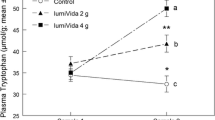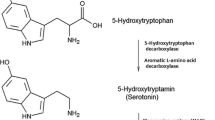Abstract
Rationale
We have previously shown that a 60-g mixture of branched chain amino acids (BCAAs) lowers the plasma availability of the catecholamine precursors tyrosine (TYR) and phenylalanine (PHE) and produces biochemical and neuropsychological changes consistent with impaired dopamine neurotransmission. However, the BCAA mixture also lowers the ratio of tryptophan (TRP) to BCAA which could impair brain serotonin function.
Objectives
To determine the biochemical and neuropsychological effects of a BCAA mixture supplemented with TRP.
Methods
We studied 32 healthy volunteers who were randomly and blindly allocated to either a single administration of amino acid mixture (60 g BCAA and 2 g TRP) or placebo. We carried out venous sampling to measure plasma levels of amino acids and performed selected cognitive tasks sensitive to monoamine manipulation 5 h after mixture ingestion.
Results
Relative to placebo, the BCAA/TRP mixture substantially lowered the ratio of TYR+PHE:BCAA and increased plasma prolactin. The ratio of TRP:BCAA was also lowered but to a lesser extent. The BCAA/TRP mixture produced significant changes in a task of decision-making where volunteers showed reduced discrimination between gambles with large and small losses.
Conclusions
A 62 g BCAA/TRP mixture decreases the availability of TYR and PHE for brain catecholamine synthesis and increases plasma prolactin consistent with lowered brain dopamine function. Addition of 2 g TRP to the 60 g BCAA mixture does not prevent a reduction of the ratio TRP:BCAA relative to placebo. The effects of the BCAA/TRP mixture on decision-making suggest a general action of dopamine pathways on the processing of emotional information in risky choice, including punishment-related cues, consistent with suggestions that dopamine mechanisms mediate behavioural responses to aversive as well as appetitive stimuli in instrumental conditioning.

Similar content being viewed by others
References
Baron J (2000) Thinking and deciding. Cambridge University Press, New York
Booij L, Van de Does AJW, Riedel WJ (2003) Monoamine depletion in psychiatric and healthy populations. Mol Psychiatry 8:951–973
Deakin JB, Aitken MR, Dowson JH, Robbins TW, Sahakian BJ (2004) Diazepam produces disinhibitory cognitive effects in male volunteers. Psychopharmacology 173:88–97
Fernstrom JD, Wurtman RJ (1971) Brain serotonin content: physiological dependence on plasma tryptophan levels. Science 173:149–152
Furst P, Pollack TA, Graser H, Godel H, Stehle P (1990) Appraisal of four precolumn derivatization methods for the high-performance liquid chromatographic determination of free amino acids in biological materials. J Chromatogr 499:557–569
Gijsman HJ, Scarnà A, Harmer CJ, McTavish SFB, Odontiadis J, Cowen PJ, Goodwin GM (2002) A dose-finding study on the effects of branch chain amino acids on surrogate markers of brain dopamine function. Psychopharmacology 160:192–197
Harmer CJ, McTavish SFB, Clark L, Goodwin GM, Cowen PJ (2001) Tyrosine depletion attenuates dopamine function in healthy volunteers. Psychopharmacology 160:105–111
Howell DC (1987) Statistical methods for psychology. PWS Publishers, Boston
Kahneman D, Tversky A (1979) Prospect theory: an analysis of decision-making. Econometrica 47:263–291
Killcross AS, Everitt BJ, Robbins TW (1997) Symmetrical effects of amphetamine and alpha-flupenthixol on conditioned punishment and conditioned reinforcement: contrasts with midazolam. Psychopharmacology 129:141–152
Koob GF, Nestler EJ (1997) The neurobiology of drug addiction. J Neuropsychiatry Clin Neurosci 9:482–497
Lieberman HR, Corkin S, Spring BJ, Garfield GS, Growdon JH, Wurtman RJ (1984) Use of nutrients that are neurotransmitter precursors to modify behaviors. Psychopharmacol Bull 20:593–587
McLean A, Rubinsztein JS, Robbins TW, Sahakian BJ (2004) The effects of tyrosine depletion in normal healthy volunteers: implications for unipolar depression. Psychopharmacology 171:286–297
McNair DM, Lorr M, Droppelman LF (1971) Manual for the Profile of Mood States. Educational and Industrial Testing Service, San Diego
McTavish SFB, Cowen PJ, Sharp T (1999a) Effect of tyrosine-free amino acid mixture on regional brain catecholamine synthesis and release. Psychopharmacology 141:182–188
McTavish SFB, McPherson MH, Sharp T, Cowen PJ (1999b) Attenuation of some subjective effects of amphetamine following tyrosine depletion. J Psychopharmacol 13:144–147
Milner JD, Wurtman RJ (1987) Tyrosine availability: a presynaptic factor controlling catecholamine release. Adv Exp Med Biol 221:211–221
Montgomery JA, McTarish SFB, Cowen PJ, Grasby PM (2003) Reduction of brain dopamine concentration with dietary tyrosine plus phenylalanine depletion: an [11C] raclopride PET study. Am J Psychiatry 160:1887–1889
Owen AM, Downes JJ, Sahakian BJ, Polkey CE, Robbins TW (1990) Planning and spatial working memory following frontal lobe lesions in man. Neuropsychologia 28:1021–1034
Richardson MA, Bevans ML, Weber JB, Gonzalez JJ, Flynn CJ, Amira L, Read LL, Suckow RF, Maher TJ (1999) Branched chain amino acids decrease tardive dyskinesia symptoms. Psychopharmacology 143:358–364
Robbins TW, Everitt BJ (1996) Neurobehavioural mechanisms of reward and motivation. Curr Opin Neurobiol 6:228–236
Rogers RD, Everitt BJ, Baldacchino A, Blackmore AJ, Swainson R, London M, Deakin JWF, Sahakian BJ, Robbins TW (1999) Dissociating deficits in the decision-making cognition of chronic amphetamine abusers, opiate abusers, patients with focal damage to the prefrontal cortex, and tryptophan-depleted normal volunteers: evidence for monoaminergic mechanisms. Neuropsychopharmacology 1:1–10
Rogers RD, Tunbridge, EM, Bhagwagar Z, Drevets WC, Sahakian BJ, Carter CS (2003) Tryptophan depletion alters the decision-making of healthy volunteers through altered processing of reward cues. Neuropsychopharmacology 28:153–162
Rogers RD, Lancaster M, Wakeley J, Bhagwagar Z (2004) Effects of beta-adrenoceptor blockade on components of decision-making. Psychopharmacology 172:157–164
Salamone JD (1994) The involvement of nucleus accumbens dopamine in appetitive and aversive motivation. Behav Brain Res 61:117–133
Scarnà A, Gijsman HJ, Harmer CJ, Goodwin GM, Cowen PJ (2002) Effect of branch chain amino acids supplemented with tryptophan on tyrosine availability and plasma prolactin. Psychopharmacology 159:222–223
Scarnà A, Gijsman HJ, McTavish SFB, Harmer CJ, Cowen PJ, Goodwin GM, (2003) Effects of a branched-chain amino acid drink in mania. Br J Psychiatry 182:210–213
Smith KA, Fairburn CG, Cowen PJ (1997) Relapse of depression after rapid depletion of tryptophan. Lancet 349:915–919
Acknowledgements
The authors would like to thank John Odontiadis, Mike Franklin and Alison Reed for technical assistance, and Rena Hockney for nursing assistance. S.F.B.McT. and P.J.C. were supported by Medical Research Council. The study was supported by a research grant from the Stanley Medical Research Institute.
Author information
Authors and Affiliations
Corresponding author
Rights and permissions
About this article
Cite this article
Scarnà, A., McTavish, S.F.B., Cowen, P.J. et al. The effects of a branched chain amino acid mixture supplemented with tryptophan on biochemical indices of neurotransmitter function and decision-making. Psychopharmacology 179, 761–768 (2005). https://doi.org/10.1007/s00213-004-2105-2
Received:
Accepted:
Published:
Issue Date:
DOI: https://doi.org/10.1007/s00213-004-2105-2




